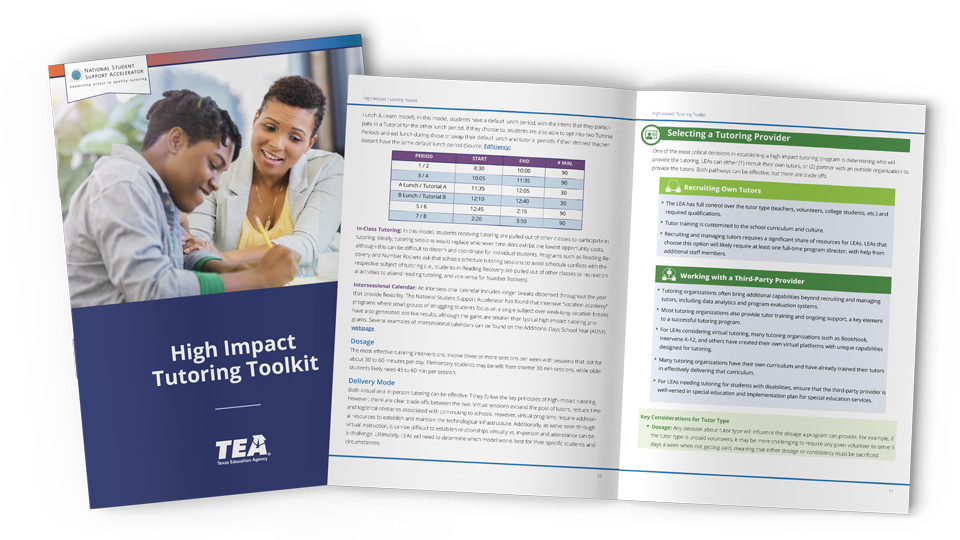Accelerated Instruction

This page provides comprehensive information emphasizing the implementation of high-impact tutoring practices to address learning gaps in students. It outlines key legislative changes in House Bill 1416, details how students failing assessments can receive specialized tutoring, and lists the characteristics of effective high-impact tutoring programs. The page offers tools, guidance, webinars, and examples, highlighting the importance of targeted support to accelerate learning and improve student outcomes in the Texas education system.
2024 Accelerated Instruction Webinar Series
Outcomes Based Contracting for HIT and Beyond
Learn more about outcomes based contracting and how your district can take the next steps in implementing OBC with vendors to positively impact student outcomes.
- Webinar Deck (PDF)
- Webinar Recording (Youtube)
Introduction to High Impact Tutoring
This webinar will provide an overview of the research and best practices needed for setting up a High Impact Tutoring Program.
- Webinar Deck (PDF)
- Webinar Recording (Youtube)
Texas Accelerated Instruction Requirements
Learn more about the requirements for meeting HB 1416. This includes the use of Teacher Incentive Allotment designated teachers and HB 1416 Ratio Waiver List providers.
- Webinar Deck (PDF)
- Webinar Recording (Youtube)
High Impact Tutoring Supports
Learn more about the various supports available for High Impact Tutoring. This includes many of the tools to assist with the development and sustainability of a program.
- Webinar Deck (PDF)
- Webinar Recording (Youtube)
Accelerated Instruction Requirements in Texas
Texas law requires all students who do not achieve approaches or higher on STAAR grades 3 through 8 or EOC assessments be provided accelerated instruction. These requirements, modified by House Bill 4545 of the 87th legislature and recently updated with the passage of House Bill 1416 in the 88th legislature, provide that qualifying students must be:
- Assigned a TIA designated teacher for the subsequent school year in the applicable subject area;
OR
- Provided supplemental instruction aligned with the research on high impact tutoring in the TEKS for the applicable grade levels and subject area in the following manner:
- No less than 15 or 30 hours depending on student performance and is provided in the summer or at least once per week in the school year;
- Limited to two subjects per year, prioritizing math and RLA;
- Provided in a group of no more than four students, unless the parent or guardian of each student in the group authorizes a larger group;
- Designed to assist the student in achieving satisfactory performance in the applicable grade level and subject area and includes effective instructional materials designed for supplemental instruction;
- Provided by a person with training in the applicable instructional materials for the supplemental instruction and provided by one person for the entirety of their accelerated instruction.
Key Changes in Requirements from HB 1416
House Bill 1416 updated accelerated instruction requirements from House Bill 4545 by:
- Removing the requirement for Accelerated Learning Committees while requiring Accelerated Education Plan after student fails to achieve approaches or higher on two consecutive assessments in the same subject area
- Limiting tutoring to 2 subjects and no longer including optional assessment administrations
- Increasing student to tutor ratio from 3:1 to 4:1 ratio for tutoring group size
- Reducing minimum hour requirement from 30 to 15 for some students*
- Providing student to teacher ratio waivers for use of approved online curriculum (approvals available mid-June 2024)
Additional details are available in the resources section below.
*HB 1416 requires TEA to define requirements for students requiring 30 hours of supplemental instruction through the rulemaking process. TEA will propose rules that will provide that students who fall into the "Low Does Not Meet" category of STAAR performance receive no less than 30 hours of supplemental instruction. The rules will also provide that students in third grade who do not approach grade level or higher will be required to receive 30 hours of supplemental instruction.
TEA Guidance
- Accelerated Instruction Webinar Deck (PDF)
- HB 1416 and Accelerated Instruction Webinar (YouTube)
- Accelerated Instruction One Pager (PDF)
- What’s Changed From HB 4545 to HB 1416 (PDF)
- Best Practices in HIT from Top Performing LEAs (PDF)
- Master Scheduling Supports Deck (PDF)
- Accelerated Instruction: HB 1416 Overview and Optional Webinar Opportunity (TAA)
Templates/Tools
- HB 1416 (88R) Supplemental Accelerated Instruction Flowchart (PDF)
- Accelerated Education Plan Best Practices Checklist — English, Spanish (Word)
- Accelerated Education Plan One Pager for Parents — English, Spanish (PDF)
- Parent Notification Letters for Accelerated Instruction Requirements — English, Spanish (Word)
Outcomes Based Contracting
2025-2026 Accelerated Instruction Waiver for Eligible School Districts/Open-Enrollment Charter Schools
The school districts or open-enrollment charter schools listed below are eligible for a one-year accelerated instruction waiver. School systems on this list met all relevant criteria (TAC §104.1001), including having at least 60% of students progress from did not meet grade level in the previous year to approaches grade level this year without any overrepresentation of student subgroups, such as those receiving special education services or who are educationally disadvantaged.
While this waiver is well-earned, we recognize the ongoing importance of offering additional academic support, such as tutoring or assigning a TIA-designated teacher, to students who have not yet met grade level expectations. This waiver is optional and should not discourage school systems from continuing to provide the support that enabled them to reach this academic milestone.
|
District # |
Name of School District/Open-Enrollment Charter School |
|---|---|
|
084804 |
AMBASSADORS PREPARATORY ACADEMY |
|
177903 |
BLACKWELL CISD |
|
203902 |
BROADDUS ISD |
|
086024 |
DOSS CONSOLIDATED CSD |
|
185902 |
FARWELL ISD |
|
065902 |
HEDLEY ISD |
|
043802 |
IMAGINE LONE STAR INTERNATIONAL ACADEMY |
|
058905 |
KLONDIKE ISD |
|
019910 |
MALTA ISD |
|
162904 |
MCMULLEN COUNTY ISD |
|
057809 |
NOVA ACADEMY |
|
015906 |
RANDOLPH FIELD ISD |
|
160904 |
ROCHELLE ISD |
|
112909 |
SALTILLO ISD |
|
049909 |
SIVELLS BEND ISD |
|
143905 |
SWEET HOME ISD |
|
056902 |
TEXLINE ISD |
|
180902 |
VEGA ISD |
|
059902 |
WALCOTT ISD |
|
062905 |
WESTHOFF ISD |
*This list does not include districts who did not have any students requiring accelerated instruction.
Eligible school districts and open-enrollment charter schools have 45 business days, October 22, 2025, to apply for the waiver using the Accelerated Instruction Waiver via TEA Login (TEAL). Guidance on additional required information and supporting documentation is available in the State Waivers Guidebook, pages 23 and 24.
High Impact Tutoring and Student Outcomes
Early data indicates that school closures and disruptions in SY19-20 and SY20-21 are likely to result in unfinished learning for many students statewide, making multi-year recovery and acceleration supports even more crucial. As LEAs consider how to best facilitate learning acceleration, many are considering high impact tutoring (HIT), as there is strong evidence that high impact tutoring is one of the most effective ways to increase learning gains for students.
High-impact tutoring programs have a few key characteristics:
Texas students have experienced academic growth post-Covid but learning acceleration is still critically needed, particularly in Math. On the 2022 STAAR, only 52% of students met grade level expectations in Reading Language Arts while only 40% of students met grade level in math.1
Evidence suggests that high impact tutoring can have a significant impact on outcomes for students:
A 2020 meta-analysis of 96 studies of high-quality tutoring programs found that students made 5 months of additional progress on average, a large pooled 0.37 effect size.1
The average effect of tutoring programs on student achievement is larger than the effects found in approximately 85% of studies evaluating education interventions and equivalent to moving a student at the 35th percentile of the achievement distribution to the 50th.2
“Teachers reported students' enthusiasm, and progress. They saw many positives to the program which they believed led to student success including the small teacher to student ratio, consistently teaching the same small group of students, consistent tutoring days and times and utilizing the program with fidelity.
Over 90% of students in the High Impact Tutoring reading program increased reading fluency from March 2022 to mid-May 2022. During that same time period, a majority of students gained ½ year reading level in less than 3 months as measured by our district reading assessment and most students improved substantially in basic reading TEKS as measured by our universal screener.”
— Administrator, Greenville ISD
1 Nickow, Andre Joshua, Philip Oreopoulos, and Vincent Quan. (2020).
2 Kraft, M. A. (2020).
Tutoring Implementation Supports
High Impact Tutoring Toolkit
Early data indicates that school closures and disruptions in SY19-20 and SY20-21 are likely to result in unfinished learning for many students statewide, making multi-year recovery and acceleration supports even more crucial. As LEAs consider how to best facilitate learning acceleration, many are considering high impact tutoring, as there is strong evidence that high impact tutoring is one of the most effective ways to increase learning gains for students.
The High Impact Tutoring Toolkit (PDF) is designed to help districts think through key pieces of program design and make connections to other helpful resources. While this toolkit is not exhaustive, it outlines the foundational principles and key considerations that all LEAs should consider when implementing a high impact tutoring program.
Toolkit Resources
Introduction & TEA Supports
- Webinar (YouTube)
- Slide Deck (PDF)
Program Design
- Webinar (YouTube)
- Slide Deck (PDF)
Program Implementation
- Webinar (YouTube)
- Slide Deck (PDF)
Scheduling
- Webinar (YouTube)
- Slide Deck (PDF)
- Examples and Resources (PDF)
Tutoring and Scheduling
- Webinar (YouTube)
- Slide Deck (PDF)
Additional Resources
District Examples
Master Schedule Examples
- Austwell-Tivoli ISD (Rural) — Elementary Schedule
- Corpus Christi ISD (Large City) — Elementary Schedule
- Corpus Christi ISD (Large City) — Middle School Schedule
- Corrigan Camden ISD (Rural) — Middle School Schedule
- Poteet ISD (Town) — Middle School Schedule
Other District Examples
School Year Staffing
Contact Information
Have questions or want to share a resource with other LEAs? Please reach out to us via our Help Desk.


